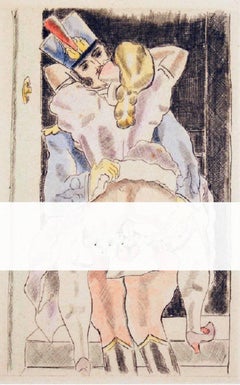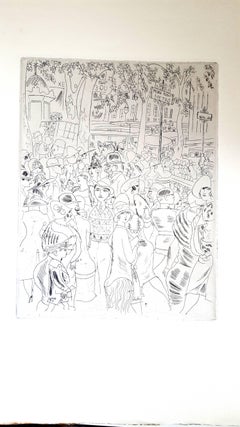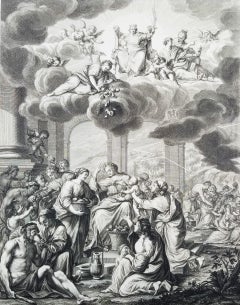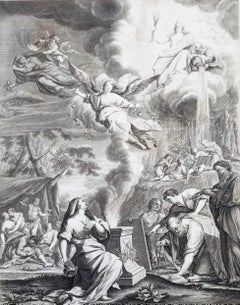Chas (Charles) Laborde Figurative Prints
to
3
Overall Width
to
Overall Height
to
1
1
1
3
846
382
380
308
3
3
3
3
2
1
1
1
1
1
1
1
1
1
1
3
1
2
1
Artist: Chas (Charles) Laborde
Illustration for "Les Chanson Erotiques" - Original Etching by Chas Laborde
By Chas (Charles) Laborde
Located in Roma, IT
Illustration for "Les Chanson Erotiques" by Pierre-Jean de Beranger.
Image Dimensions :15 x 13.5 cm
This artwork is shipped from Italy. Under existing legislation, any artwork in It...
Category
1920s Post-Impressionist Chas (Charles) Laborde Figurative Prints
Materials
Etching
Tendres Stocks: The Complete Etchings
By Chas (Charles) Laborde
Located in New York, NY
Chas Laborde (1886-1941), Tendres Stocks: The Complete Etchings, c. 1924, etching, engraving, colored etching proofs before publication of the book. A suite of 13 impressions in black and white, and 13 in color; 26 in all; impressions printed before the book edition of Tendres Stocks by Paul Morand...
Category
1920s Art Deco Chas (Charles) Laborde Figurative Prints
Materials
Color, Engraving, Etching
Chas Laborde - Paris - Capucine's Boulevard - Original Etching
By Chas (Charles) Laborde
Located in Collonge Bellerive, Geneve, CH
Chas Laborde - Paris - Capucine's Boulevard - Original Etching
Dimensions : 13 x 10".
Paper : Rives vellum.
Edition : 225 copies.
1927
From Tableaux de Paris, Emile-Paul Freres, Paris
Chas LABORDE
Charles Laborde was born in Buenos Aires on August 8, 1886. He was the youngest of the five sons of Adolphe-Sylvestre Laborde-Pinou, a Basque-Bearne millionaire who had made a fortune selling spirits to the Indians and luxury goods imported from France to wealthy Argentines. The family returned to France when Charles was six months old. His mother died when he was two. He spent his childhood at their family château d’Escout outside Oloron-Sainte-Marie in the Pyrenees. His brothers went to a boarding-school, his father was often in Paris on business, and little Charles was left to his devices. Though it was a lonely childhood, he was a darling of his generous and magnanimous father. Charles got his early drawing skills from a village artist and found support in his brother Jean-Felix. Charles frequently accompanied his father visiting artisans and helped him choose de luxe objects to be sold in Argentine.
He first attended the Rollin college in Paris, then a lyceum in Pau, where he lived with full board and lodging after his father’s death in 1901. From childhood Charles wanted to be an artist and tried several pseudonyms for himself: Ch. Laborde, Carlos Laborde,Carlos Edrobal and Carl Lab. He started wearing a velvet suit and a large hat. At 17, the timid shortsighted teenager wearing big glasses was expelled from college for smoking and drinking alcohol and went to Paris into the custody of his elder brother Jean-Felix, who carried on his father’s business. Charles enrolled in the prestigious l’Académie Julian, studying under Henri Royer and Marcel Baschet. Simultaneously he was a pupil of William Bouguereau and Luc-Olivier Merson at l’École des Beaux-Arts. The latter was famous for being the designer of the 50 and 100 franc banknotes, and he believed that he was teaching a “little Daumier”.
In England, where he went every year from 1905 to 1914 with the family of his friend Cooper, a classmate at l’Académie Julian, he found not only his pseudonym Chas (short for Charley), but also the land of his dreams. Peculiarities of London and its inhabitants were reflected in drawings of William Hogarth and Thomas Rowlandson, whose album The Microcosm of London (1808) prompted Charles to make his London Streets Scenes (1928). Owing to those trips Charles took a liking to the atmosphere of England and its reserved and terse humor.
In 1905 the château d’Escout and the Buenos Aires Commercial Fund were sold. After coming into inheritance, Laborde became financially independent and obtained an atelier in Montmartre at 11 bis Rue des Saules. His neighbors were de la Butte, Francis Carco and Pierre Mac Orlan, who sympathized with the easy-going young man with a positive attitude to life. His friend Pierre Falke...
Category
1920s Modern Chas (Charles) Laborde Figurative Prints
Materials
Etching
Related Items
Meridies; Der Mittag (Noon; The Midday) /// Johann Daniel Preissler Old Master
Located in Saint Augustine, FL
Artist: (after) Johann Daniel Preissler (German, 1666-1737)
Title: "Meridies; Der Mittag (Noon; The Midday)"
Portfolio: Die Vier Tageszeiten (The Four Times of Day)
Year: 1723
Medium: Original Etching and Engraving on laid paper
Limited edition: Unknown
Printer: likely Johann Balthasar Probst, Augsburg, Germany
Publisher: Jeremias Wolff (Erben), Augsburg, Germany
Reference: Le Blanc No. 255, 38; Nagler No. 23
Sheet size: 22.5" x 16.32"
Image size: 18.13" x 14.32"
Condition: Soft handling creases and folds to sheet. A few light areas of staining and scattered small areas of discoloration in margins. Two small tears skillfully repaired from verso in margins. Has been professionally stored away for decades. It is otherwise a strong impression in good condition with full margins
Extremely rare
Notes:
Provenance: private collection - Aspen, CO. Engraved by German artist Johann Balthasar Probst (1673-1750) after a drawing by German artist Johann Daniel Preissler (1666-1737). Comes from Preissler's 1723 "Die Vier Tageszeiten (The Four Times of Day)" portfolio of four etchings and engravings. Printed from one copper plate in one color: black. Descriptions of the portrayed image are printed in Latin and German.
Biography:
Johann Daniel Preissler, or Preisler (1666–1737) was a German painter and director of Nuremberg's Academy of Fine Arts. He was a notable member of a German artistic family, originating in Bohemia. His children included Johann Justin Preissler (1698–1771), Georg Martin Preisler (1700–1754), Barbara Helena Preisler (1707–1758; married to Oeding), Johan Martin Preisler (1715–1794), and Valentin Daniel Preisler (1717–1765), all in their time renowned artists. Most notable for his portraits, nudes and history paintings, Johann Daniel Preissler also produced drawings and frescoes. He was particularly known beyond his native Nuremberg for his "Die durch Theorie erfundene Practic", a sequence of works on art theory – the individual works were translated into several other languages and served as textbooks for students such as the Swiss Salomon Gessner...
Category
1720s Old Masters Chas (Charles) Laborde Figurative Prints
Materials
Laid Paper, Engraving, Etching
$900
H 22.5 in W 16.32 in
Aurora sive Tempus Matutinum; Der Wohl und Übel angewandte Morgen /// Old Master
Located in Saint Augustine, FL
Artist: (after) Johann Daniel Preissler (German, 1666-1737)
Title: "Aurora sive Tempus Matutinum; Der Wohl und Übel angewandte Morgen (Dawn or Morning Time; The Morning Used for Better or For Worse)"
Portfolio: Die Vier Tageszeiten (The Four Times of Day)
Year: 1723
Medium: Original Etching and Engraving on laid paper
Limited edition: Unknown
Printer: likely Johann Balthasar Probst, Augsburg, Germany
Publisher: Jeremias Wolff (Erben), Augsburg, Germany
Reference: Le Blanc No. 255, 38; Nagler No. 23
Sheet size: 22.57" x 16.38"
Image size: 17.75" x 14"
Condition: Soft handling creases, folds, and scattered faint areas of discoloration to sheet. Three tears skillfully repaired from verso. Has been professionally stored away for decades. It is otherwise a strong impression in good condition with full margins
Extremely rare
Notes:
Provenance: private collection - Aspen, CO. Engraved by German artist Johann Balthasar Probst (1673-1750) after a drawing by German artist Johann Daniel Preissler (1666-1737). Comes from Preissler's 1723 "Die Vier Tageszeiten (The Four Times of Day)" portfolio of four etchings and engravings. Printed from one copper plate in one color: black. Descriptions of the portrayed image are printed in Latin and German.
Biography:
Johann Daniel Preissler, or Preisler (1666–1737) was a German painter and director of Nuremberg's Academy of Fine Arts. He was a notable member of a German artistic family, originating in Bohemia. His children included Johann Justin Preissler (1698–1771), Georg Martin Preisler (1700–1754), Barbara Helena Preisler (1707–1758; married to Oeding), Johan Martin Preisler (1715–1794), and Valentin Daniel Preisler (1717–1765), all in their time renowned artists. Most notable for his portraits, nudes and history paintings, Johann Daniel Preissler also produced drawings and frescoes. He was particularly known beyond his native Nuremberg for his "Die durch Theorie erfundene Practic", a sequence of works on art theory – the individual works were translated into several other languages and served as textbooks for students such as the Swiss Salomon Gessner...
Category
1720s Old Masters Chas (Charles) Laborde Figurative Prints
Materials
Laid Paper, Engraving, Etching
$900
H 22.57 in W 16.38 in
Vespera; Der Abend (Evening; The Evening) /// Johann Daniel Preissler Old Master
Located in Saint Augustine, FL
Artist: (after) Johann Daniel Preissler (German, 1666-1737)
Title: "Vespera; Der Abend (Evening; The Evening)"
Portfolio: Die Vier Tageszeiten (The Four Times of Day)
Year: 1723
Medium: Original Etching and Engraving on laid paper
Limited edition: Unknown
Printer: likely Johann Balthasar Probst, Augsburg, Germany
Publisher: Jeremias Wolff (Erben), Augsburg, Germany
Reference: Le Blanc No. 255, 38; Nagler No. 23
Sheet size: 22.5" x 16.63"
Image size: 17.38" x 13.63"
Condition: Soft handling creases and folds to sheet. Some scattered foxmarks in left margin. Two small tears skillfully repaired from verso in margins. Has been professionally stored away for decades. It is otherwise a strong impression in good condition with full margins
Extremely rare
Notes:
Provenance: private collection - Aspen, CO. Engraved by German artist Johann Balthasar Probst (1673-1750) after a drawing by German artist Johann Daniel Preissler (1666-1737). Comes from Preissler's 1723 "Die Vier Tageszeiten (The Four Times of Day)" portfolio of four etchings and engravings. Printed from one copper plate in one color: black. Descriptions of the portrayed image are printed in Latin and German.
Biography:
Johann Daniel Preissler, or Preisler (1666–1737) was a German painter and director of Nuremberg's Academy of Fine Arts. He was a notable member of a German artistic family, originating in Bohemia. His children included Johann Justin Preissler (1698–1771), Georg Martin Preisler (1700–1754), Barbara Helena Preisler (1707–1758; married to Oeding), Johan Martin Preisler (1715–1794), and Valentin Daniel Preisler (1717–1765), all in their time renowned artists. Most notable for his portraits, nudes and history paintings, Johann Daniel Preissler also produced drawings and frescoes. He was particularly known beyond his native Nuremberg for his "Die durch Theorie erfundene Practic", a sequence of works on art theory – the individual works were translated into several other languages and served as textbooks for students such as the Swiss Salomon Gessner...
Category
1720s Old Masters Chas (Charles) Laborde Figurative Prints
Materials
Laid Paper, Engraving, Etching
$900
H 22.5 in W 16.63 in
Don Juan
By Louis Icart
Located in Missouri, MO
Aquating Engraving
Image Size: approx. 20 1/4 x 13 3/8
Framed Size: 28 x 20.5 inches
Pencil Signed Lower Right
Louis Justin Laurent Icart was born in Toulouse in 1890 and died in Paris in 1950. He lived in New York City in the 1920s, where he became known for his Art-Deco color etchings of glamourous women.
He was first son of Jean and Elisabeth Icart and was officially named Louis Justin Laurent Icart. The use of his initials L.I. would be sufficient in this household. Therefore, from the moment of his birth he was dubbed 'Helli'. The Icart family lived modestly in a small brick home on rue Traversière-de-la-balance, in the culturally rich Southern French city of Toulouse, which was the home of many prominent writers and artists, the most famous being Henri de Toulouse-Lautrec.
Icart entered the l'Ecole Superieure de Commerce de Toulouse in order to continue his studies for a career in business, particularly banking (his father's profession). However, he soon discovered the play writings of Victor Hugo (1802-1885), which were to change the course of his life. Icart borrowed whatever books he could find by Hugo at the Toulouse library, devouring the tales, rich in both romantic imagery and the dilemmas of the human condition. It was through Icart's love of the theater that he developed a taste for all the arts, though the urge to paint was not as yet as strong for him as the urge to act.
It was not until his move to Paris in 1907 that Icart would concentrate on painting, drawing and the production of countless beautiful etchings, which have served (more than the other mediums) to indelibly preserve his name in twentieth century art history.
Art Deco, a term coined at the 1925 Paris Exposition des Arts Decoratifs, had taken its grip on the Paris of the 1920s. By the late 1920s Icart, working for both publications and major fashion and design studios, had become very successful, both artistically and financially. His etchings reached their height of brilliance in this era of Art Deco, and Icart had become the symbol of the epoch. Yet, although Icart has created for us a picture of Paris and New York life in the 1920s and 1930s, he worked in his own style, derived principally from the study of eighteenth-century French masters such as Jean Antoine Watteau, François Boucher and Jean Honoré Fragonard.
In Icart's drawings, one sees the Impressionists Degas...
Category
1920s Art Deco Chas (Charles) Laborde Figurative Prints
Materials
Engraving, Aquatint
Itzchak Tarkay "Visiting Friends" 2001 Signed Serigraph, Artist Proof
By Itzchak Tarkay
Located in Miami, FL
ITZCHAK TARKAY – "VISITING FRIENDS"
⚜ Serigraph in Color on Wove Paper ⚜ Hand Signed and Annotated AP 23/90 ⚜ Gilt Wood Frame
VIBRANT INTERIOR PORTRAIT
Printed in 2001, "Visiting Fr...
Category
Early 2000s Post-Impressionist Chas (Charles) Laborde Figurative Prints
Materials
Archival Paper, Screen
$1,350 Sale Price
25% Off
H 16.875 in W 14.875 in D 1.25 in
Itzchak Tarkay [Café Friends] 2001 Signed Serigraph, Hors Commerce Proof
By Itzchak Tarkay
Located in Miami, FL
ITZCHAK TARKAY – [CAFÉ FRIENDS]
⚜ Serigraph in Color on Wove Paper ⚜ Hand Signed and Annotated HC 27/80 ⚜ Gilt Wood Frame
CAFÉ SCENE WITH ELEGANT DETAIL
Executed circa 2001, [Café F...
Category
Early 2000s Post-Impressionist Chas (Charles) Laborde Figurative Prints
Materials
Archival Paper, Screen
$1,125 Sale Price
25% Off
H 15.125 in W 13.125 in D 1 in
Itzchak Tarkay "Sweet Thoughts" 2001 Signed Serigraph, European Artist Proof
By Itzchak Tarkay
Located in Miami, FL
ITZCHAK TARKAY – "SWEET THOUGHTS"
⚜ Serigraph in Color on Wove Paper ⚜ Hand Signed and Annotated EA 10/80 ⚜ Gilt Wood Frame
INTIMATE INTERIOR WITH FLORAL DETAIL
Created in 2001, "Sw...
Category
Early 2000s Post-Impressionist Chas (Charles) Laborde Figurative Prints
Materials
Screen, Archival Paper
$1,350 Sale Price
25% Off
H 16.875 in W 14.875 in D 1.25 in
Maternity : Mother and Child - Etching
By Mary Cassatt
Located in Paris, IDF
Mary Cassatt (1844-1926)
Maternal Love
Engraving after a pastel
Signed in the plate
On vellum, 50 x 38 cm (c. 20 x 15 in)
INFORMATION: Copperplate engraving published by the Galer...
Category
Early 20th Century Post-Impressionist Chas (Charles) Laborde Figurative Prints
Materials
Etching, Aquatint
Pair of Hand-colored Romantic French Engravings after Francois Boucher
By (After) Francois Boucher
Located in Alamo, CA
A pair of French classical romantic prints original created in the 18th century by Jacques-Firmin Beauvarlet (1731-1797) after paintings by Francois Boucher (1703-1770), utilizing ...
Category
18th Century Romantic Chas (Charles) Laborde Figurative Prints
Materials
Engraving, Etching
$2,375
H 28.5 in W 23.63 in D 1.13 in
Nude XIII - XXI Century, Contemporary Figurative Drypoint Etching Print
By Marta Wakula-Mac
Located in Warsaw, PL
MARTA WAKUŁA-MAC: Master of Arts in Fine Art Education- Diploma in Fine Art Printmaking at the Institute of Art, Pedagogical University, Krakow, 2003. Member of Graphic Studio Dubl...
Category
2010s Contemporary Chas (Charles) Laborde Figurative Prints
Materials
Paper, Drypoint, Etching
$179 Sale Price
20% Off
H 6.5 in W 3.15 in
Sportsmen
By Louis Legrand
Located in Storrs, CT
Sportsmen. 1908. Etching and drypoint. Exsteens 271.i/ii. 11 1/4 x 5 3/4 (sheet 17 3/8 x 12 1/4). Series: Les Bars. From the first state edition of 30 proofs with the remarque sketch...
Category
Early 1900s Post-Impressionist Chas (Charles) Laborde Figurative Prints
Materials
Drypoint, Etching
Rapunzel, Rapunzel, let down your hair David Hockney Brothers Grimm Fairy Tales
By David Hockney
Located in New York, NY
From David Hockney’s celebrated Six Fairy Tales from the Brothers Grimm portfolio, an image from the story of Rapunzel, which he chose for its popularity. When illustrating the princ...
Category
1960s Modern Chas (Charles) Laborde Figurative Prints
Materials
Etching, Aquatint
Chas (charles) Laborde figurative prints for sale on 1stDibs.
Find a wide variety of authentic Chas (Charles) Laborde figurative prints available for sale on 1stDibs. You can also browse by medium to find art by Chas (Charles) Laborde in etching, engraving and more. Much of the original work by this artist or collective was created during the 1920s and is mostly associated with the Post-Impressionist style. Not every interior allows for large Chas (Charles) Laborde figurative prints, so small editions measuring 7 inches across are available. Customers who are interested in this artist might also find the work of Félix Vallotton, John Edward Costigan, and Maurice de Vlaminck. Chas (Charles) Laborde figurative prints prices can differ depending upon medium, time period and other attributes. On 1stDibs, the price for these items starts at $750 and tops out at $1,297, while the average work can sell for $836.



